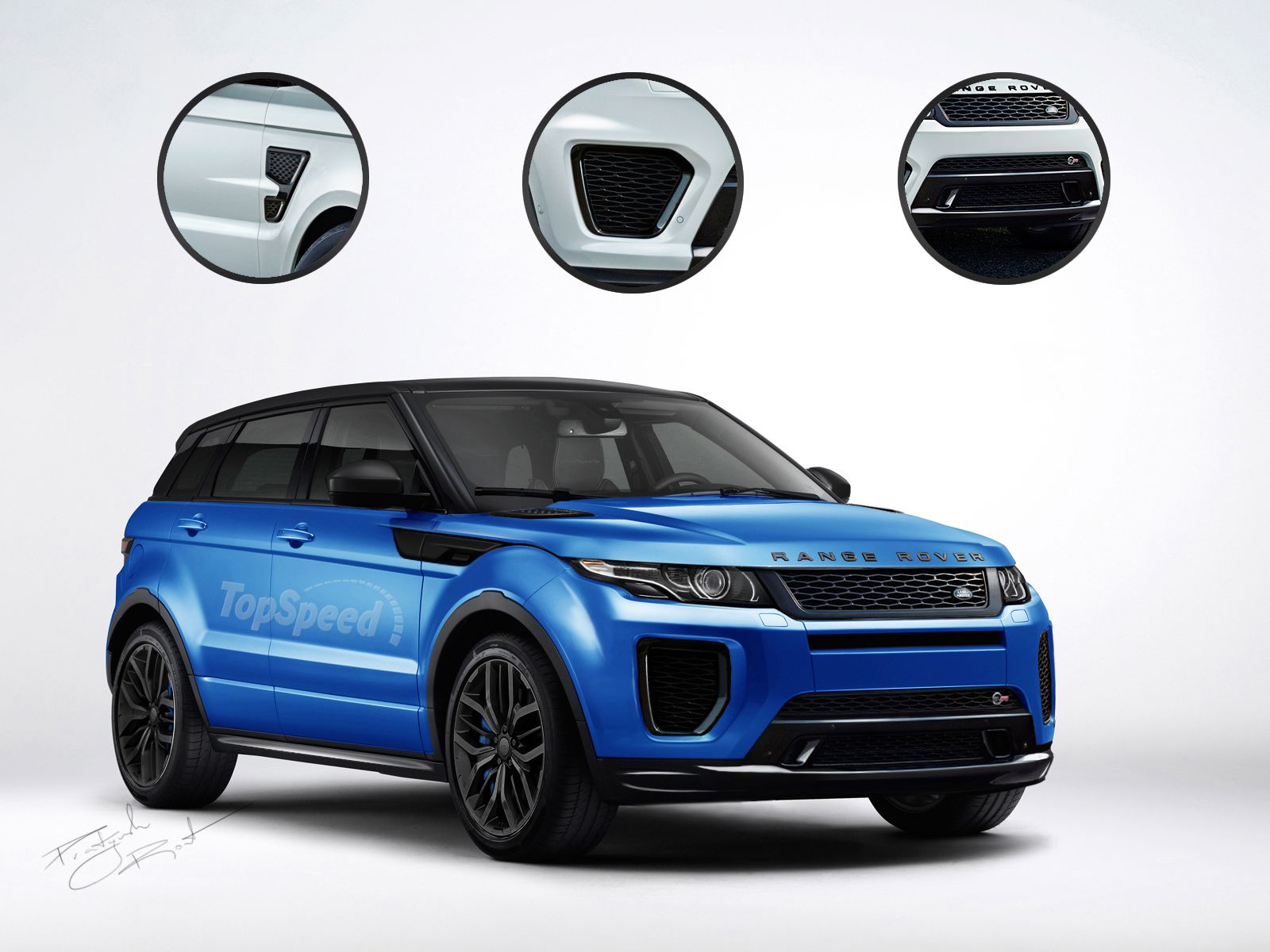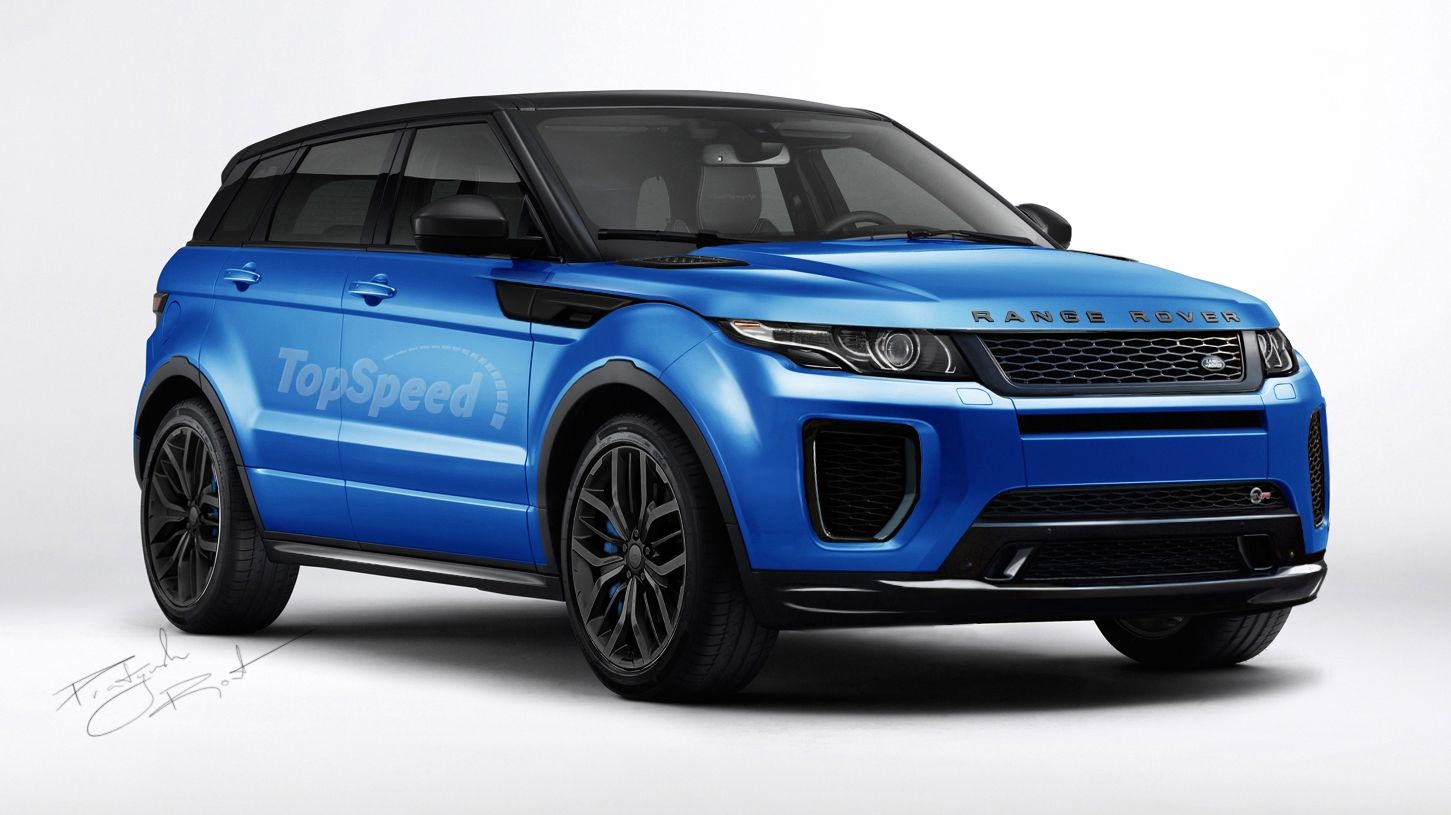Nothing is life is a certainty; that’s especially true in what the future holds in the automotive world. Just last week I wrote about Land Rover’s->ke46 Program Chief Murray Dietsch saying an SVR-badged Range Rover Evoque wasn’t in the works. Sadly, he said such a vehicle would be “cost prohibitive” and could not meet the high performance expectations set forth by SVR engineers. However, since nothing is a guarantee, what if JLR actually moved forward with the build? Behold TopSpeed’s idea of a 2016 Range Rover Evoque SVR.
Looking a lot like its big brother, the Range Rover Sport, the Evoque SVR gets a revamped grille, larger side vents, a new wheel and tire package, and black accents touching nearly every body panel.
The Evoque SVR is certainly not official, but we can still dream. Just imagine a track toy that can hold its own yet still trudge its way up a muddy cattle trail heading up to the hunting lodge.
Click past the jump to read more about the Land Rover Range Rover Evoque SVR.
land-rover-range-rover-evoque-svr
- Make: Array
- Model: land-rover-range-rover-evoque-svr
2016 Land Rover Range Rover Evoque SVR
- Make: Array
- Model: 2016 Land Rover Range Rover Evoque SVR
- Engine/Motor: inline-4
- Horsepower: 325
- Transmission: Nine-speed automatic
- [do not use] Vehicle Model: Array
Exterior
The Evoque SVR borrows much of its looks from the Range Rover Sport. Like the Sport, the Evoque’s reshaped front end brings more air into the engine bay while heat extractors along the hood and front fenders keep temperatures in check. The larger wheel package supports low-profile tires with grippy compound for track duty. Gone are the front fog lamps to make way for more air inlets.
Also like the Ranger Rover Sport, the Evoque’s roof, mirror caps, grille trim, and accent panels are all finished in gloss black. Regardless of body color, the accents give it a menacing appearance.
Interior
Range Rover Sport SVR Shown
The interior accommodations would see a nice improvement in seat bolstering and reliance on upgraded leather coverings. Don’t expect the Evoque’s overall interior design to change. Like the Range Rover Sport, the seats would look as if they were pulled from a supercar. The large side bolstering means Alcantara isn’t needed for grip, leaving the seats to be covered in the finest Windsor Leather. Aluminum bright work would dresses up the dashboard and center console in keeping with the upscale look.
All the niceties Range Rovers are known for would still be present. Expect the same rotary dial for the transmission while a row of buttons operate the Terrain Response 2 system. The leather covered dash still houses the same infotainment screen while the gauge cluster still uses its analog speedometer and tachometer with the information screen embedded between.
Drivetrain
One thing Murray Dietsch said in his statements to motoring.com.au was the D8 lineup of vehicles (Land Rover Discovery Sport and Range Rover Evoque) would be cost prohibited in terms of performance verses value. Acknowledging that statement yet choosing to ignore it (or postulate it’s a diversion), the Range Rover Evoque SVR would need to generate well above 300 horsepower in order to earn its high-performance badge.
Its current engine is the 2.0-liter four-cylinder that produces 240 horsepower at 5,500 rpm and 250 pound-feet of toque at a low 1,750 rpm. Now that Ford-derived engine is set to be replaced in the near future by a clean-sheet JLR engine. Perhaps that engine – already known to be a turbocharged 2.0-liter four-cylinder – could be capable of making 300+ horsepower. That, combined with the Range Rover’s fantastic AWD system, is the key to getting the Evoque to perform like a sports car.
The current nine-speed automatic transmission will likely carry over with the new engine, even in the standard Evoque. For SVR duty, expect a nice reprogram of its shift logic, making it more apt to hold gears and provide snappy shifts.
Prices
Here’s where things get sticky. Cost is a major factor in the Range Rover Evoque becoming a reality as Dietsch says it limited the vehicle’s audience. So how much would it cost? Considering the Range Rover Sport SVR costs an additional $19,000 above the top-trim Autobiography edition, the Evoque would likely see the same price hike. Regularly starting at $56,600 for the top-trim Evoque Dynamic, the SVR version would likely cost roughly $75,000.
Competition
2015 Audi SQ5
The SQ5 is a compact crossover more purposed for on-road ventures than off, powered by the respectable 3.0-liter, supercharged V-6 making 354 horsepower and 347 pound-feet of toque. An eight-speed automatic transmission sends power to Audi’s Quattro AWD system. The sprint to 60 mph comes in just 5.2 seconds on its way to a limited 155-mph top speed. There are such things as performance SUVs.
Pricing starts at $52,795 and goes north from there.
2017 BMW X3 M
Though it’s not out yet, the X3 M has been confirmed by BMW as being in the works. Like the Audi, the BMW will be a dedicated on-road machine though AWD will likely be added for extra grip. Powering the X3 M will likely be the same turbocharged 3.0-liter inline six-cylinder as found in the M3 and M4 sedan and coupe. That mill produces a surprising 425 horsepower and 406 pound-feet of toque. Sixty mph should happen in around five seconds flat and top speed will be limited like Audi to 155 mph.
Expect pricing to start in excess of $60,000.
Conclusion
Sure, this might be a pipe dream at this point, but the possibility is still there. What if Land Rover decided to build an all-out performance version of its Range Rover Evoque? The though sure is tempting.
With a strong engine under the hood and the AWD system sending power to all four of the low-profile tires, the Evoque SVR makes performance sense. Let’s just hope JLR can make financial sense out of it and allow engineers to build it.



